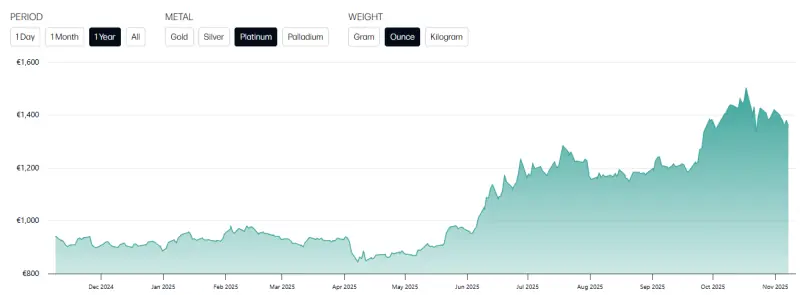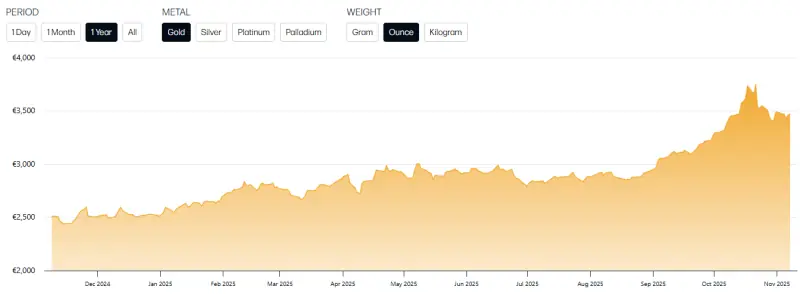Oct 2025
Oct 2025
Is Platinum More Expensive Than Gold?
By StoneX Bullion
Platinum is much rarer than gold, which leads many investors to assume it must cost more. But at today's prices, platinum is trading at approximately $1,636 while gold sits at more than $4,094. Why is that?
To understand why platinum costs less than gold, we have to examine the unique characteristics of each metal, what makes them valuable, and the forces that drive their prices.
What makes gold valuable?
Gold has been valued for thousands of years for its rarity and versatility. One of gold’s most unique features is its softness and malleability, which allows it to easily be shaped into intricate designs without breaking. This is why gold is used in everything from fine jewellery to coins and even aerospace components.
Another reason why gold is valuable is its durability. It’s one of the few metals that doesn’t rust, tarnish, or corrode – this is why you often see archaeologists digging up perfectly intact ancient gold artefacts even after hundreds of years underground. It has a natural lustre that never fades, and it can be alloyed with other metals to create different hues (e.g. yellow gold, white gold, or rose gold).
See: What is White Gold and What are its Characteristics?
Gold is also universally regarded as a store of wealth. It’s traded in every major economy, with central banks holding it as part of their reserves, investors buying it to hedge against inflation, and everyday consumers holding gold in the form of jewellery or other decorative pieces.
To sum up, the key characteristics that make gold valuable include:
- Soft and highly malleable
- Easy to shape into intricate designs
- Resistant to tarnish and corrosion
- Available in various hues when alloyed with other metals
- Globally recognised as a store of value.
Learn More: Density of Gold: A Simple Guide and Tables
What makes platinum valuable?
Platinum’s value comes from its rarity, strength, and purity. It’s one of the densest elements on Earth, around 11% heavier than gold, which gives it a distinct weight and premium feel. You’ll often find that a platinum ring will feel more substantial in the hand compared to a pure gold ring of the same size.
Because of its durability, platinum is highly resistant to scratches and wear, which is why it’s often preferred for engagement rings, wedding rings, and any jewellery designed for everyday wear. It also has a naturally bright white sheen that doesn’t fade or require replating or polishing to maintain its appearance.
When it comes to rarity, platinum is roughly 30 times rarer than gold. The majority of the world’s platinum supply comes from just a handful of regions, with South Africa producing around 70% of global output.
Despite its rarity, platinum is in high demand thanks to its numerous industrial applications. It’s especially essential in the automotive industry, where it’s used in catalytic converters that reduce harmful vehicle emissions. Platinum is also used in chemical processing, electronics, and medical devices. This combination of scarcity + industrial necessity only adds to platinum’s value.
In short, the unique characteristics that make platinum valuable include:
- Naturally bright white colour that never fades
- Extremely dense and durable
- Resistant to scratches, heat, and corrosion
- Hypoallergenic
- Exceptionally rare
- High industrial demand.
Keep Reading: How to Invest in Platinum: Tips & Strategies
Differences between gold and platinum
To truly understand the price dynamics of each precious metal, let’s look a little closer at their differences.
Physical properties
The most obvious difference between gold and platinum is their appearance – gold has a warm yellow hue that has symbolised wealth and prestige for thousands of years, while platinum has a naturally white, silvery tone that gives it a much cooler look.
Both metals are known for their density, though platinum is denser than gold. This means platinum jewellery will feel slightly heavier compared to gold jewellery, even when both pieces are the same size.
Platinum is also much harder to work with compared to gold. It has a melting point of about 1,768℃ (1,947℉), which makes the white metal more durable but also more difficult and expensive to refine or shape. Gold, on other hand, is soft and malleable with a much lower melting point of 1,064 °C (1,943℉). This makes it easier to mould into different shapes, which is why gold is so popular in jewellery making.
Chemical properties
Gold and platinum are both noble metals, which means they’re highly resistant to corrosion and oxidation. They don’t rust or tarnish over time and they’re unaffected by most acids, which helps keep their appearance intact over time. This natural resilience makes them ideal for long-term investment and heirloom pieces that can be passed down for generations.
See: Does Gold Rust?
Source & availability
Gold is mined all over the world, with major production hubs in the United States, South Africa, Russia, Canada, Australia, and China. Platinum production, on the other hand, is geographically concentrated, with more than two-thirds of the world’s supply coming from South Africa, along with smaller outputs from Russia, Zimbabwe, and Canada.
Rarity & production
Platinum is much rarer than gold. In 2024, for example, approximately 3,300 metric tons of gold was produced from mines, compared to just 186 metric tons of platinum. This scarcity is one of the main reasons why platinum has often traded at a premium to gold, although market demand and industrial use can shift this balance over time (as it currently has).
Why is platinum cheaper than gold?
So, we’ve established that platinum is rarer than gold, so why is gold more expensive? The answer lies in market behaviour, investor confidence, and platinum’s price volatility.
Gold’s value comes from its global reputation as a store of value. It’s the most popular precious metal used by investors, institutions, and central banks to hedge against inflation and economic instability.
With inflation rising in recent years, so has demand for gold. Investors from all over the world turn to gold to protect their wealth, and this demand reinforces itself – when more people buy gold, its prices go up, which makes even more people want to buy gold. This creates a positive feedback loop that keeps pushing gold prices higher over time.
Gold’s appeal also comes from its stability. Unlike platinum, which is tied to industrial demand, gold’s value is built on trust and perception. It’s a tangible, universally recognised asset that’s known to hold its worth even when other markets fluctuate.
The platinum market, on the other hand, is much smaller and more volatile than the gold market. Its value depends heavily on industrial demand, especially from the automotive sector where it’s used in catalytic converters. This industrial dependence makes platinum vulnerable to economic slowdowns, regulatory changes, and technological shifts. For example, the rise of electric vehicles (EVs) has reduced demand for catalytic converters, sending platinum prices down.
That said, there have been times where platinum has outperformed gold – in mid-2014, for example, platinum traded at around $1,450 per ounce compared to gold's $1,268 per ounce – but these periods tend to be short-lived (it’s been more than a decade since platinum traded above gold).
At the end of the day, platinum is traded far less than gold, making it more susceptible to price swings, and therefore a riskier asset for some investors.
See: What Drives the Price of Gold?
Gold and platinum prices over time
Let’s see how gold and platinum prices have changed over time.
In the early 1920s, gold traded at around $370-380 per ounce, which is equivalent to about $7,000 in today’s dollars. Prices surged after the Nixon Shock of 1971, which ended the gold standard. By 1974, gold was trading at over $1,080 per ounce, and by 1980, it had reached $2,600 (inflation-adjusted). The 2008 financial crisis and subsequent global instability pushed gold above $2,400 per ounce by 2011, and as of October 2025, the yellow metal is trading at nearly $4,000 per ounce.
Platinum hasn’t been popular for nearly as long as gold. In 1969, it sold for about $230 per ounce (roughly $1,920 today). In 1980, its price rose sharply alongside gold, reaching $960 per ounce before stabilising between $350-340 for much of the 1990s. In early 2008, platinum hit an all-time-high of $2,290 per ounce, briefly trading above gold. But by the end of the same year, it had crashed to $780 in the midst of the global recession. Today, platinum trades at around $1,500.
Platinum prices over time

Gold prices over time

Summary: Is platinum more expensive than gold?
Platinum is currently trading at a lower price than gold because its value is more closely tied to industrial demand and broader economic cycles. Even though platinum is much rarer than gold, it’s also more volatile, and its price tends to fluctuate with changes in manufacturing and automotive production.
Gold, on the other hand, is a universal store of value that tends to remain stable, or even increase, during periods of inflation or market uncertainty. This stability makes gold consistently more expensive, even though it’s more abundant in nature.
That said, both precious metals have their own unique characteristics that make them valuable investments, and each has a place in a well-balanced portfolio. If you’re considering precious metals investment, the best way to invest in both gold and platinum is through bullion bars and coins, which give you direct ownership of the metal itself.
At StoneXBullion, you’ll find a wide range of investment-grade gold and platinum bullion products sourced directly from the world’s most trusted mints and refiners. Whether you’re looking to diversify your holdings or start your precious metals journey, you’ll find a suitable item amongst our range. Browse our collection now.